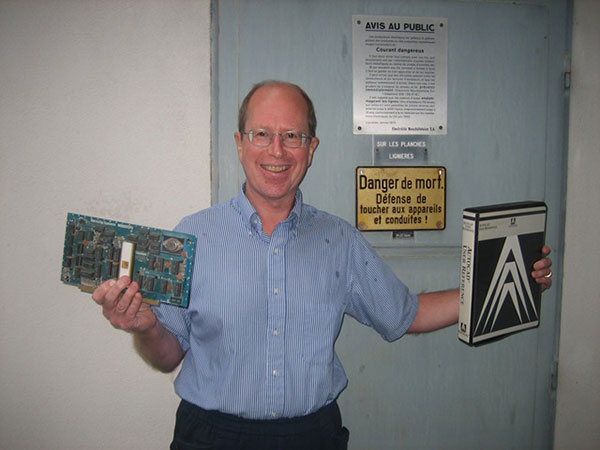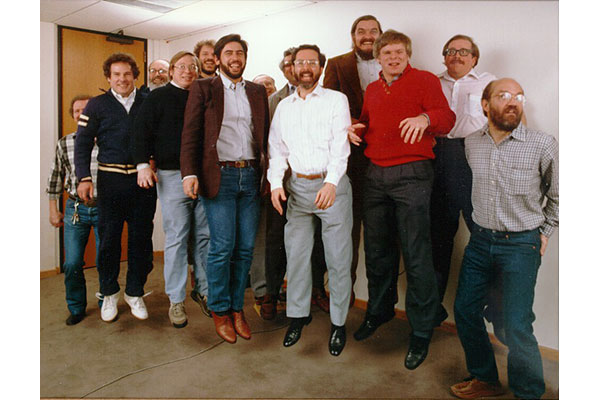Remembering Autodesk Co-Founder, Polymath and Programming Pioneer
He spent a lifetime tinkering, inventing and striving to make the world a more engaging, interesting place to discover.

John Walker holding an M9900 board and the prototype hardcover manual for AutoCAD version 2.1. Images courtesy of David Cohn.
Latest News
February 16, 2024
John Walker, a computer technology pioneer and co-founder of Autodesk, died on Friday, February 2, 2024, in Neuchatel, Switzerland at the age of 74, from injuries after a fall.
In early 1982, at the age of 33, John and fellow programmer Dan Drake met with 12 other friends at John’s home in Mill Valley, CA, planting the seed for what would become Autodesk. Originally called Marin Software Partners, their initial plan was for the partners to “select a set of products to develop” and pool their financial resources to bring the most promising of those products to market, an act that John called “guerilla programming.”

Founding Autodesk
Eschewing the family tradition of becoming a medical doctor, John attended Case Western Reserve University to pursue a career in astronomy. After discovering the burgeoning new world of computers, however, he changed his focus to computer science, receiving a degree in electrical engineering. After graduation, John and his wife Roxie moved to California where he worked for various companies before teaming up with Dan Drake to form Marinchip Systems. There, John designed a circuit board for the then-new Texas Instruments TMS9900 microprocessor.
Marinchip also pioneered the translation of numerous computer language compilers to other personal computing platforms, most notably the Intel processors used in the IBM PC. By 1981, however, John recognized that the game had changed and there was a unique opportunity for a small software-only company to provide programs for what he saw as a “coming tidal wave of small computers from large manufacturers.”
“I think that we’re at an absolutely unprecedented juncture of history. I can’t think of any time in the entire human experience when so much opportunity existed for technical people, opportunity which they could participate in with very little risk,” Walker was once quoted as saying. “Most great business opportunities have required far greater infusions of startup capital, which was consumed just [in] paying for [the] physical plant before anything was made to sell. Our products are created by almost pure mental effort, and are manufactured on trivially cheap equipment at a tiny fraction of their wholesale cost. It’s almost like counterfeiting, but legal.”

In short order, a group of 17 founders pooled $59,000, and focused most of their efforts on INTERACT, a CAD program written by Mike Riddle that ran on the board created by Walker and Drake. The company paid $1,200 for a booth at the 6th West Coast Computer Faire, where on March 19, 1982, the company unveiled its program, now renamed MicroCAD. The program proved to be one of the hits of the show, with several other vendors demonstrating the new software in their booths as well, because it helped show off the capabilities of these new “personal computers.”
The turning point came half a year later when the company showed AutoCAD at the COMDEX trade show in Las Vegas in November 1982. By then, Riddle, who had signed a nonexclusive marketing agreement in return for royalty payments, had little further involvement with Walker’s version of the software.
With a starting price of just $1,000, AutoCAD delivered 80% of the capabilities of existing CAD systems—proprietary software running on expensive, proprietary systems—for less than 20% of the cost. Sales during its first year totaled $14,733 and the company lost $9,465. But that proved to be the first and only time the company he co-founded lost any money.
After Autodesk
Autodesk went public in 1985 and by the following year had grown to 255 employees with annual sales of over $40 million. That year, Walker resigned as chairman and president of the company, continuing to work as a programmer. Annual revenues reached $100 million in 1989.
Walker moved to Switzerland in 1991, in part to avoid U.S. taxes and also to be closer to his wife’s fieldwork in Egypt. By the time he resigned from Autodesk in 1994, it was the sixth-largest personal computer software company in the world. Annual revenue for the 12 months ending October 31, 2023, was $5.35 billion.
After leaving Autodesk, John continued to tinker, invent and work on personal projects, which he documented at www.fourmilab.ch. His endeavors included a hardware random number generator as well as astronomy software including an Earth and Moon Viewer and Your Sky, an interactive planetarium.
His writings include The Autodesk File, which chronicles the early years of Autodesk, The Hacker’s Diet (humorously subtitled “How to lose weight and hair through stress and poor nutrition”), which approaches weight loss “as an engineering problem”, the frequently cited article “The Digital Imprimatur” about Internet censorship, and numerous science fiction short stories. In recent years, he was a frequent contributor to the online community portal Ricochet.
John is survived by his wife, bioarchaeologist Roxie Walker (a director of the Institute for Bioarchaeology at the British Museum), and his brother Bill Walker of West Virginia. It is reported that he will be buried in a pasture on property he and his wife own on the Isle of Man.
Contributing editor David Cohn started using AutoCAD in 1984. He has written more than a dozen books about AutoCAD, was one of the first AutoCAD third-party developers, and is the former editor of CADalyst, an AutoCAD magazine. You can contact him via email at [email protected] or visit his website.
More Autodesk Coverage
Subscribe to our FREE magazine, FREE email newsletters or both!
Latest News
About the Author
David Cohn is a consultant and technical writer based in Bellingham, WA, and has been benchmarking PCs since 1984. He is a Contributing Editor to Digital Engineering, the former senior content manager at 4D Technologies, and the author of more than a dozen books. Email at [email protected] or visit his website at www.dscohn.com.
Follow DE






